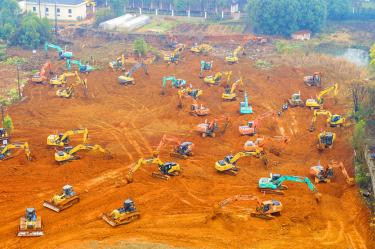Chinese authorities yesterday expanded their mammoth quarantine effort to 13 cities and a staggering 41 million people, as nervous residents were checked for fevers and the death toll from the 2019 novel coronavirus (2019-nCoV) climbed to 26.
A range of Lunar New Year festivities have been canceled, while temporary closures of Beijing’s Forbidden City, Shanghai Disneyland and a section of the Great Wall were announced.
The WHO said China faced a national emergency, but stopped short of making a declaration that would have prompted greater global cooperation, including possible trade and travel restrictions.
With hundreds of millions of people on the move across China for the Lunar New Year holiday, the government has halted all travel out of Wuhan, shut down its public transport and told residents to stay at home.
Normally bustling streets, malls and other public spaces were eerily quiet in Wuhan on the second day of its lockdown.
Masks were mandatory in public, and images from the city showed empty shelves as people stocked up for what could be an extended isolation.
Train stations, the airport and subways were closed; police checked incoming vehicles, but did not entirely close off roads.
Hospitals visited by journalists bustled with worried patients being screened by staff wearing full-body protective suits.
At a temperature-check station, a medical staffer in bodysuit, mask and goggles took a thermometer from a middle-aged woman, pausing to examine the reading before quickly turning back to the patient.
“Have you registered? Then go and see the doctor,” the staffer said.
One 35-year-old man surnamed Li voiced the fears of many.
“I have a fever and cough, so I’m worried that I’m infected,” he said. “I don’t know the results yet.”
A taxi driver in Wuhan, who asked not to be named, said: “This year we have a very scary Chinese New Year. People are not going outside because of the virus.”
However, a prolonged shutdown should not pose food-shortage problems because many people had stocked up for the holiday, he said.
In addition to Wuhan, 12 other smaller cities nearby have battened down the hatches, with most of them going public yesterday with various measures ranging from closing public venues and restricting large gatherings, to halting public transportation and asking citizens not to leave their cities.
As reports surfaced of bed shortages in Wuhan hospitals, state media said authorities were rushing to build a new facility devoted to the outbreak by Feb 3.
It is to have a capacity of 1,000 beds spread over 25,000m2, Xinhua news agency said.
Dozens of excavators and trucks were filmed working on the site by state television.
Xiaotangshan Hospital was erected on the outskirts of Beijing in barely a week in 2003 to cater to a rapidly rising number of SARS patients.
It consisted of prefabricated structures and Xinhua said Wuhan was building the new facility based on the same model.
China Central Television reported that 40 medical doctors from the military were being brought in to help with intensive care at Wuhan Pulmonary Hospital.
Chinese authorities said the number of cases leapt overnight to more than 800, with 177 in serious condition. There were another 1,072 suspected cases.
Officials also said that a virus patient died in Heilongjiang Province, the second death outside Wuhan.
Beijing has canceled popular New Year public events at temples in the capital, the historic Forbidden City is to close from today, and Shanghai Disneyland said it would also shut today for an indefinite period to protect visitors and staff.
To discourage travel, the government has said all tickets for rail, air, road or water transport could be exchanged for a refund.
Source: Taipei Times - 2020/01/25





















